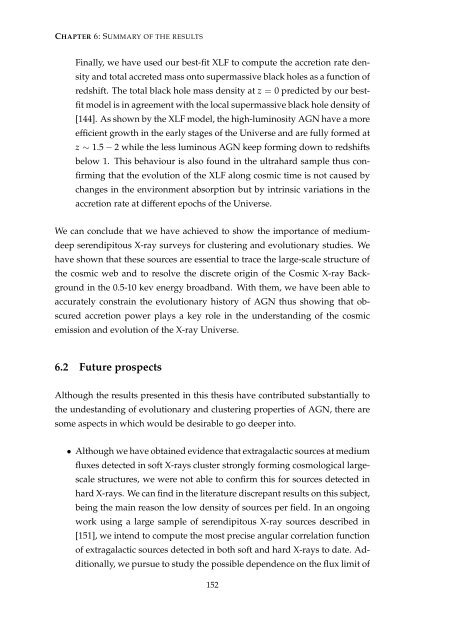pdf - SRON
pdf - SRON
pdf - SRON
Create successful ePaper yourself
Turn your PDF publications into a flip-book with our unique Google optimized e-Paper software.
CHAPTER 6: SUMMARY OF THE RESULTS<br />
Finally, we have used our best-fit XLF to compute the accretion rate density<br />
and total accreted mass onto supermassive black holes as a function of<br />
redshift. The total black hole mass density at z = 0 predicted by our bestfit<br />
model is in agreement with the local supermassive black hole density of<br />
[144]. As shown by the XLF model, the high-luminosity AGN have a more<br />
efficient growth in the early stages of the Universe and are fully formed at<br />
z ∼ 1.5 − 2 while the less luminous AGN keep forming down to redshifts<br />
below 1. This behaviour is also found in the ultrahard sample thus confirming<br />
that the evolution of the XLF along cosmic time is not caused by<br />
changes in the environment absorption but by intrinsic variations in the<br />
accretion rate at different epochs of the Universe.<br />
We can conclude that we have achieved to show the importance of mediumdeep<br />
serendipitous X-ray surveys for clustering and evolutionary studies. We<br />
have shown that these sources are essential to trace the large-scale structure of<br />
the cosmic web and to resolve the discrete origin of the Cosmic X-ray Background<br />
in the 0.5-10 kev energy broadband. With them, we have been able to<br />
accurately constrain the evolutionary history of AGN thus showing that obscured<br />
accretion power plays a key role in the understanding of the cosmic<br />
emission and evolution of the X-ray Universe.<br />
6.2 Future prospects<br />
Although the results presented in this thesis have contributed substantially to<br />
the undestanding of evolutionary and clustering properties of AGN, there are<br />
some aspects in which would be desirable to go deeper into.<br />
• Although we have obtained evidence that extragalactic sources at medium<br />
fluxes detected in soft X-rays cluster strongly forming cosmological largescale<br />
structures, we were not able to confirm this for sources detected in<br />
hard X-rays. We can find in the literature discrepant results on this subject,<br />
being the main reason the low density of sources per field. In an ongoing<br />
work using a large sample of serendipitous X-ray sources described in<br />
[151], we intend to compute the most precise angular correlation function<br />
of extragalactic sources detected in both soft and hard X-rays to date. Additionally,<br />
we pursue to study the possible dependence on the flux limit of<br />
152
















